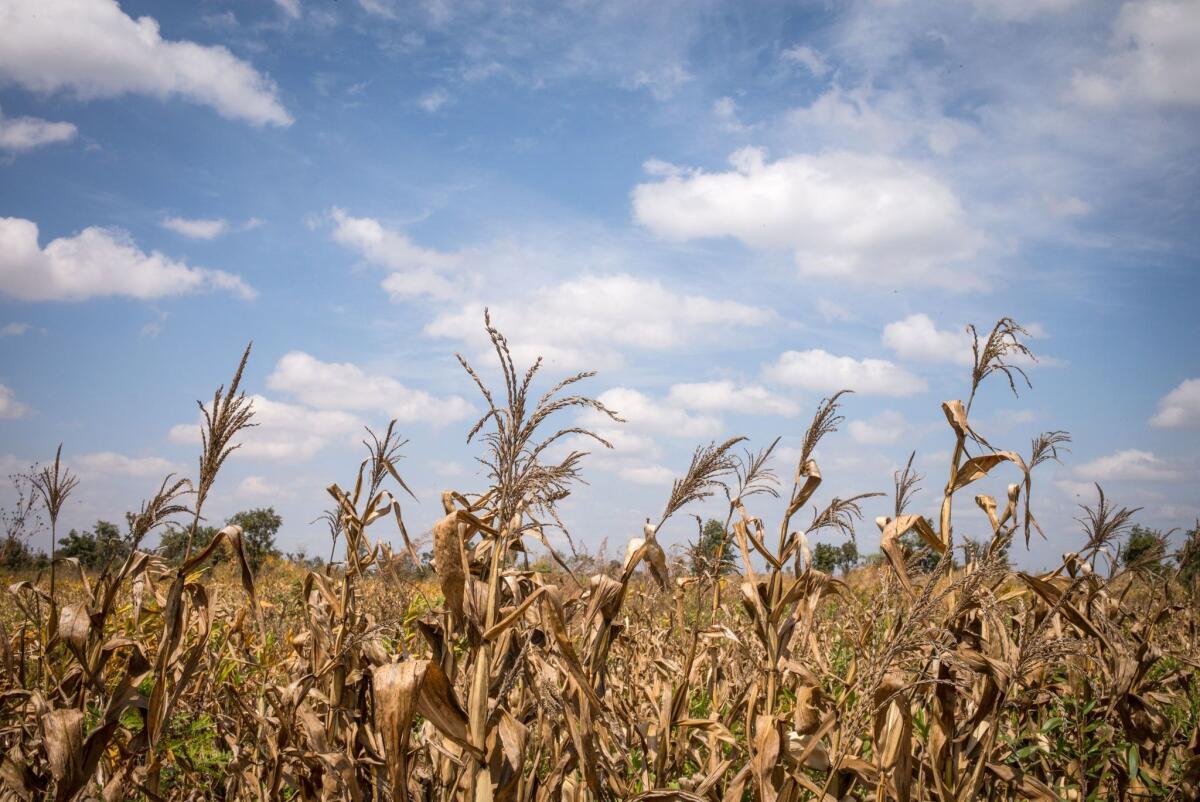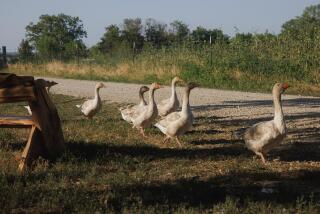Op-Ed: African farmers need the tools and technology to adapt to a changing climate

This 2015 photo shows the impact of drought in Lubumbashi in the southeastern region of the Democratic Republic of Congo.
Climate change has condensed the cycles of devastating drought, and agriculture across Africa and the world is feeling the heat. Lack of rain in southern Africa delayed this year’s planting season by up to two months. Planted areas have shrunk, crops have wilted and food production in South Africa is already down 25%.
Meanwhile, far to the north in Ethiopia, the worst drought in 30 years threatens the food security of more than 10 million people, and in neighboring Somalia, around 3 million people have been hit by crop failures and food shortages. Across Africa and the globe, farmers need tools and technologies that will enable them to adapt to a changing climate.
When those resources are available, people can be spared the worst effects of drought -- and continue to eat. Take California. Despite the drought that has plagued the state for four years, farmers have continued to feed the U.S. population by switching from thirsty crops such as almonds to more hardy ones such as pomegranates. They are also adopting more efficient water-management technologies, such as advanced drip irrigation, and California agriculture is beginning to benefit from the nation’s most advanced seawater desalination plant.
Agricultural research is also revealing other new and effective approaches to adapt to climate change. For example, scientists are studying and using beneficial microbes from soil to strengthen plant resilience to increased drought, diseases and pests brought on by climate change. My research at Auburn University has demonstrated that microbes can help plants such as corn, cotton and tomato survive drought by growing bigger and longer roots that allow them to capture more water from soil.
The ability of farmers to adapt, however, varies enormously depending on the region and its wealth. Developing countries often lack these resources and choices -- and are worst hit by this extreme weather. To protect the most vulnerable farmers and consumers and to ensure global food security amidst a changing climate, farmers must be empowered to create agricultural solutions that correspond to their own local realities.
Farmers in Kenya, Tanzania, Ethiopia and many other African countries are planting more drought-tolerant varieties of staple crops such as maize, and they are changing their farming practices to get more crop for each drop of water.
But in Africa, where 95% of farming is rain-fed, crop production is almost entirely dependent on the weather. Furthermore, millions of farmers in Africa remain uninformed of the scope of climate level changes they are experiencing. Without such information, they are unable to plan and adjust their farming practices to be sustainable for the long term.
But there are innovators who are changing this. In the Kenyan village of Mutomo, for example, one smallholder farmer armed with a camera and a phone took it upon himself to monitor weather extremities and their impact on his family and community. He was able to detect early indications of changing rainfall patterns that would likely affect the growing season. He is now using this knowledge to educate his community, and local farmers are planting drought-tolerant crop varieties and using low-cost, simple drip irrigation.
This approach of involving Africa’s millions of small farmers in collecting climate-related data is the best way to jumpstart the adaptation to climate change in Africa. The data from millions of farmers monitoring daily weather changes, rainfall levels and patterns and soil health will shed light on overall climate trends.
About two-thirds of Africans now have mobile phones, including many in rural areas, and these could play an integral part in the collection of weather and soil data. Data collected by farmers on their phones could then be aggregated and analyzed by designated research institutions, national meteorology agencies or government extension agents so the resulting trends can be shared with farmers.
To get this initiative rolling, governments can play a pivotal role in initiating powerful coalitions of public and private partners. In Uganda, for example, the Trans African Hydro-Meteorological Observatory will empower local communities and small-scale farmers across the country with an early warning weather system for severe weather across the drought-prone Cattle Corridor, the flash-flood prone highlands and other areas. The project leverages ubiquitous cellphones, and partners with mobile operators and the Ugandan National Meteorological Authority to provide low-cost, on-demand access to weather alerts to more than 16 million Ugandan cellphone users.
But for such programs to be most effective, it is key to establish two-way information flows between farmers and service providers. For example, a program developed by the global nonprofit Grameen Foundation and partners in Uganda used data collected from small-scale farmers to detect, notify and control the outbreak of dangerous weather-sensitive outbreaks of crop disease. Farmers can be indispensable contributors to, not just consumers of, climate-related farming data.
Armed with this information, farmers could adjust their farming plans to reduce risks to crops and increase yields. For example, if the trend predicted below average rainfalls, farmers might be prompted to plant drought-resistant crops, and if the forecasts indicated adequate rainfall, farmers might choose to plant riskier, but more productive, crops. While these types of technologies exist, they rarely operate at a large scale, and often miss the mark as far as adequately engaging and training farmers.
This data would also be invaluable in helping inform governments and research institutions to guide their formulation of disaster-management strategies.
Of course, providing farmers with such tools for adaptation is not enough to completely shield them from the effects of complex and unpredictable weather events. But it is an essential step toward climate-proofing African agriculture. African farmers must be able to understand climate-related impacts on their crops, be part of developing tools to adapt to a changing climate and have access to a full suite of tools to strengthen their resilience.
Natural disasters, such as drought, are already becoming more common and governments, companies, NGOs, farmers and ordinary citizens must act with urgency. We must employ every tool at our disposal to curb the likelihood of, prepare for and respond to climate change and natural disasters that put our global food supply -- and the millions who rely on it -- at risk.
Helping farmers grow food in the face of extreme weather disasters would require new creative solutions, visions and partnerships. It is time for citizens, governments, universities and private partners to join together to empower smallholder farmers with the tools they need to navigate the climate challenges ahead.
Esther Ngumbi is a research scientist at Auburn University in Alabama and a 2015 Aspen New Voices Fellow.
ALSO
91 Freeway in O.C. reopens after 2-hour standoff; suspect in custody
San Andreas fault ‘locked, loaded and ready to roll’ with big earthquake, expert says
Inside North Korea’s Children’s Palace, a reporter finds children turning into robotic grown-ups
More to Read
Sign up for Essential California
The most important California stories and recommendations in your inbox every morning.
You may occasionally receive promotional content from the Los Angeles Times.










